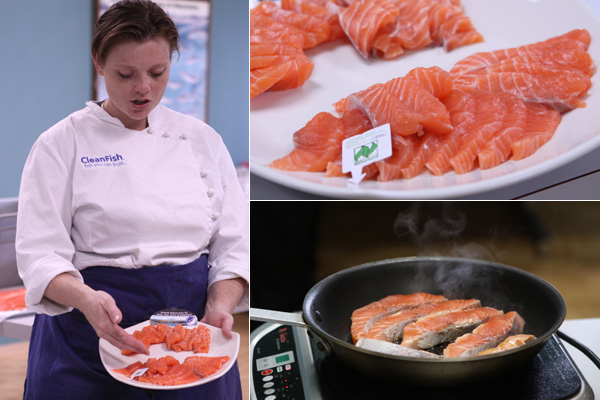
“If you can’t trust your fish distributor, you really don’t know what you’re getting,” Polly Legendre tells a roundtable of Minnesota chefs. Legendre, culinary director of San Francisco based CleanFish, last week visited American Fish and Seafood, a Hopkins based wholesaler, to educate chefs about the organization’s approach to seafood sustainability.
CleanFish, a self-described “seafood brokerage company,” is symbolic of a growing trend throughout eating establishments nationwide: the purposeful practice of serving and educating customers about sustainable seafood. Established in August 2004 by veteran environmentalist Tim O’Shea and seafood industry specialist Dale Sims, CleanFish has established an international network of vetted fisheries, both wild and farm-raised. It is comprised of three segments: one section buys and sells fish, another works on education and image, and the third, an ecological advisory board, does the vetting.
According to Legendre, the organization is attempting to bring integrity back to the fishing industry. Rather than supporting the “big fish,” (so to speak), of the seafood industry, they foster the growth of small fisheries, which otherwise would not have the means to grow their operations. “We want to keep feeding the world, but in an artisanal way,” she says.
Sustainable fishing is an alarmingly important topic, as the imbalance between the decline of ocean life and the increase in consumer seafood demand has reached a tipping point. According to the Monterey Bay Aquarium’s 2009 State of Seafood Report, the decline in seafood is primarily attributed to commercial fishing and the “failure to consider the entire ecosystem when managing fisheries and aquaculture operations.” To put it simply, people want more seafood, and in order to meet these needs seafood harvesters are industrializing themselves in an attempt to keep up. This practice works against the natural ocean cycle, and is not good news for the fish, or the environment.
2009 marked a significant moment in the human diet of seafood. For the first time ever, farm-raised consumption has surpassed wild. With the rapidly increasing demand, wild-caught seafood simply can’t keep up with our diets. Yet, with the bad news also comes some good. Also included in the report are the significant strides made thanks to a unification agreement between marine ecologists and fisheries management scientists, an increase in international policy on fishery management and practices, and a commitment from large-scale retailers, such as Walmart, to support sustainable seafood choices. It seems fair to say that everyone on the boat can agree on one point; a commitment to seafood sustainability is crucial and needs to be addressed now.

During the presentation, local chefs were sampled of several products backed by CleanFish, including the small but surprisingly tasty Laughing Bird Shrimp from Belize, a meaty Irish organic salmon, and a vibrantly colored and tender New Zealand Blue Abalone.
Rick Kimmes, executive chef at Oceanaire in Minneapolis and one of the chefs in attendance, has used both Laughing Bird Shrimp and Loch Duart Salmon repeatedly in his menu. After tasting the New Zealand Blue Abalone, he commented on the tenderness. “Traditionally you’d need to tenderize it. It’s usually rock hard. But this is softer. It tastes like chicken liver.”
As chefs sampled, Legendre relayed the stories behind the fisheries they support. One such story came from the Muckleshoot Tribe in Puget Sound. Historically, Native American tribes in this region have celebrated the salmon and depended on it for the tribe’s financial means. In this community, the salmon is viewed as a sacred species that embodies the sun. Salmon have a unique life cycle, in that they hatch in freshwater, swim to the ocean to mature, and eventually return to the site of their birth to spawn. During this last leg of life, they absorb the sun and fertilize the land around them. Their sustainability is crucial to the tribe, both financially and symbolically.
Recent environmental changes have led to a decline in the Muckleshoot’s salmon harvest. But their commitment to quality has not diminished. Through the use of internal audits, only quality salmon are harvested. If a section of the tribe doesn’t take care of their harvest they are fined, because they’re bringing down the tribe, and in a chain reaction, the community. “That’s integrity. This is what’s important,” says Legendre.
Another supplier is a husband and wife team from Texas who raise redfish. The husband farms the fish, the wife boxes them. Another supplier of striped bass hails from Colorado, in the 10th poorest county in the nation. “These people don’t have the money or time to go through certification process, so we’re telling their stories. These are people who actually want to do the right thing.”

Currently, CleanFish does not carry any seafood from Minnesota lakes, or the Great Lakes area. Minnesotans have proven they are interested in eating local and sustainable seafood, (as demonstrated by the success of Sea Change in Minneapolis), but unlike beef, poultry, or pork, the availability of local seafood is limited.
CleanFish hopes the visit to American Fish and Seafood will help accomplish their goal of increasing local chefs’ usage of sustainable seafood, and in a timely manner. Rather than creating a new distribution channel in Minnesota, they opted to work in an already existing system by distributing through American Fish and Seafood. Legendre’s visit was meant to educate and expose local chefs to a new way of approaching seafood, and encourage them to make and endorse sustainable choices.
“Once this arrives at your door, it’s your responsibility to complete the cycle of sustainability to teach your staff about where it’s coming from,” she tells the group of chefs. “By completing the cycle, it’s actually giving someone the opportunity to participate in something good. It’s giving someone the opportunity to choose. Little by little everyone can make a difference.”
